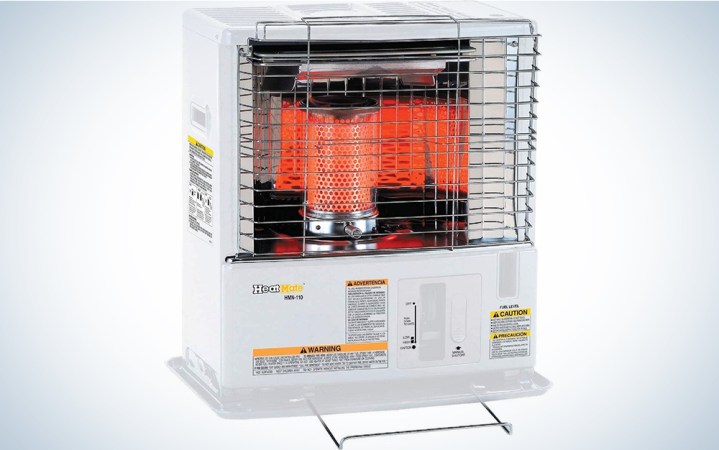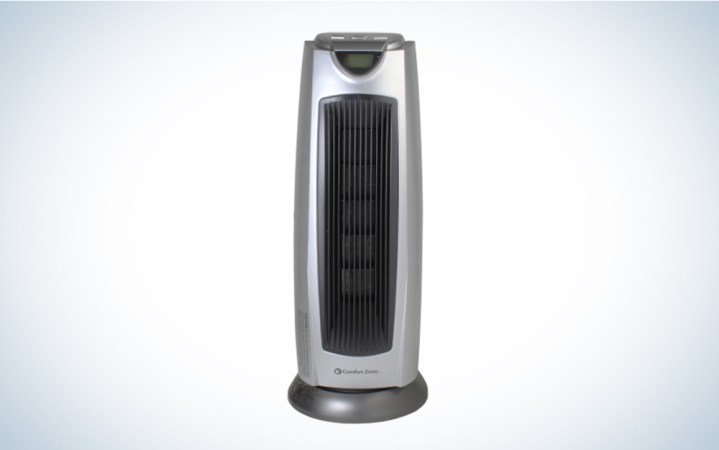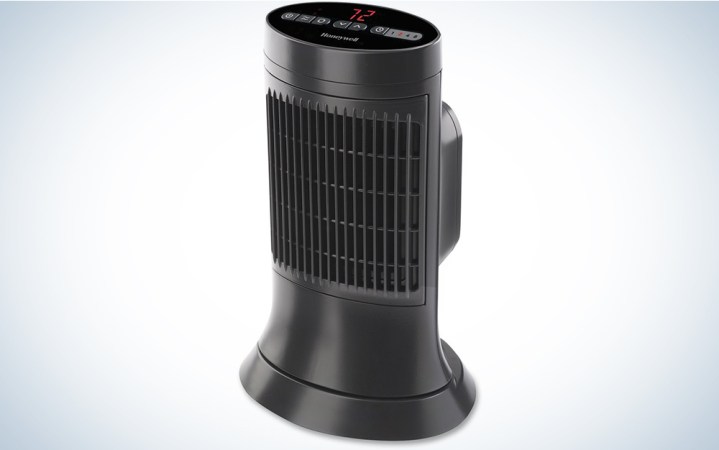We may earn revenue from the products available on this page and participate in affiliate programs. Learn More ›
Sometimes central heating just won’t cut it against blustery drafts. Or maybe you’re working in a garage, or on a camping or hunting trip and don’t have access to heat at all. If that’s the case, having the best personal heater will be a cold-weather essential. Depending on the conditions you’re in, your specifications for a personal heater will change. If you need a little extra heat inside your house, or in a drafty cubicle, an electric heater makes the most sense. But if you’re working in a garage or on a construction site, a fuel-burning unit may be your best bet.
Kerosene and propane heaters have come a long way from the fiery infernos they once were, so you don’t have to fear for your safety when you power one up. A portable propane heater is perfect for heating up an ice shack, keeping a garage from freezing, or staying warm while camping—but remember to crack a window or two if you’re in an enclosed space to get proper ventilation. Keep reading to find out what is the most efficient electric heater, the best gas heater for on the go, and the best personal heater to buy if you’re on a budget.
- Best Electric Personal Heater: TaoTronics Ceramic Tower Oscillating Portable Heater
- Best Kerosene Personal Heater: Sengoku KeroHeat 10,000-BTU Indoor/Outdoor Portable Radiant Kerosene Heater
- Best Propane Heater: Mr. Heater 20,000 BTU Blue Flame Propane Heater
- Best Space Heater for Indoors: Comfort Zone Digital Ceramic Oscillating Electric Tower Heater/Fan with Remote Control
- Best Portable Heater: Mr. Heater Buddy Portable Propane Radiant Heater
- Best Personal Heater Under $50: Honeywell Digital Ceramic Compact Heater
Things to Consider When Shopping for the Best Personal Heater
The three most important things to consider when shopping for the best personal heater are the size of the space you need to heat, if electricity is available, and the ventilation of the space. We have you covered for every scenario, from electric heaters to kerosene heaters to propane versions.
Do You Need an Electric Heater or a Gas Heater?
If you’re mostly working indoors in a building that wired for electricity, in a room that always feels drafty or that central heat just doesn’t seem to travel to, you’ll want an electric heater. The best electric space heaters heat up a room quickly, and are adjustable and reliable.
In order for the personal heater to work its magic quickly, you’ll want to consider the size of the room you want to heat. Take into account the BTU rating and wattage of the unit you’re considering. If only the wattage is listed, you can use a Watt to BTU online calculator to determine how that translates. British Thermal Units, or BTUs, measure the amount of energy needed to raise the temperature of one pound of water by one degree. If you want to know how many BTUs it will take to heat up your space, multiply the square footage of the room by 20. If your room is 100 square feet, it requires at least 2000 BTUs.
Meanwhile, if you’re in a place that has ventilation — a barn, a warehouse, a tent — you should consider a gas heater. Most are one of two types: kerosene and propane. Kerosene heaters work by igniting a wick that’s infused with kerosene, and the open flame emits heat. Some kerosene heaters have controls that let you adjust the height of the flame, and in turn the heat output. The wick is extinguished when it’s lowered back into a mechanism at the bottom of the heater. Because they have an open flame, look for added safety features such as auto shut-off, a tip-over switch that extinguishes the flame if the heater is knocked over, and protective safety grills guarding the flame.
Many propane heaters are catalytic heaters, meaning that they generate heat without a flame. The heat source is a plate where the propane and oxygen burn in a very efficient manner, and provide heat. There’s no kerosene to cart around, and you can hook up large propane tanks to them for long periods of heat.
Best Electric Heater: TaoTronics Ceramic Tower Oscillating Portable Heater

This remote-control-operated electric heater turns up to 70 degrees to warm you from multiple angles, and features three heating modes, from 900 watts to 1500 watts. There’s also an ECO mode where the space heater alternates between temperatures based on the condition of the room in order to save power.
Best Kerosene Heater: Sengoku KeroHeat 10,000-BTU Indoor/Outdoor Portable Radiant Kerosene Heater
Powerful Unit
This portable kerosene heater can be used indoors or outdoors, and it features a handy fuel gauge so you know when gas is running low. A siphon pump lets you add more safely. This indoor or outdoor heater can generate up to 10,000 BTUs, and it features an automatic shut-off and tip-over switch. The 1.2 gallon-fuel capacity can heat for up to 14 hours.
Best Propane Heater: Mr. Heater 20,000 BTU Blue Flame Propane Heater
Can Be Wall Mounted
This propane heater is a good choice for places such as garages and outbuildings. It has a helpful automatic shut-off feature when oxygen runs low. Most garages have plenty of small openings to outside air, but if your garage is fairly air-tight, crack a door or window to make sure there’s plenty of oxygen in the space.
Will You Be Using the Personal Heater Indoors?
As we mentioned before, an electric personal heater is best for indoor use, when you know you’ll have a consistent and easy-to-access power source. Some electric models are small enough to perch on a desk in a chilly office, or on a nightstand as you wind down before bed. Many are ceramic heaters, which means they have ceramic plates attached to heated coils. The plates absorb the heat and release them into the room. Ceramic heaters are generally fairly cost-effective and do not use a lot of energy.
Best Space Heater for Indoors: Comfort Zone CZ499R 1500 Watt Ceramic Oscillating Digital Tower Heater
80-Degree Oscillation
This ceramic heater has a remote control that lets you adjust the oscillation (or the direction the heater faces), the two heat settings that range from 59 degrees to 86 degrees Fahrenheit, the timer, and the shut-off button.
What Portable Heater is Effective both Indoors and Outdoors?
A personal heater is a useful and cost-efficient way to heat up a space in case of a power outage, or if you’re on a hunting or fishing trip and need an effective way to stay warm. Many people want a portable heater that can go easily from place to place inside or out. If that’s you, an indoor-safe portable propane heater is a good choice, as long as you can provide some ventilation to assure safe combustion.
Best Portable Heater: Mr. Heater Buddy Portable Propane Radiant Heater
Rugged Go-To
This 4,000 to 9,000 BTU, portable heater comes with safety features like an auto shut-off that activates if the heater gets knocked over, the pilot light goes out, or oxygen levels dip too low. It can run for up to three hours at maximum BTU, but will last longer at lower heat settings.
Best Budget Personal Heater: What You Get for Under $50
There are lots of great space heaters on the market, even if you’re looking for something under $50. Remember, personal safety is paramount, so make sure your heater has an auto-off tip over switch and a timer function if you think you might forget to switch it off.
Budget space heaters may not be able to heat up a large room, but these typically aren’t your primary sources of heat—and if they are, it’s often in a small space. You might lose out on extras, like a remote control, but most heaters come with easy-to-read digital controls or LCD screens now.
Best Budget Personal Heater: Honeywell Digital Ceramic Compact Heater
Easy and Dependable
This mini heater packs all the safety features we mentioned above and more, including an overheat safety protection and a plastic design that stays cool to the touch, which you’ll be thankful for if you accidentally bump into it, or a child or pet touches it. There are two heat settings, and the timer can be set anywhere between one to eight hours.
FAQs
Things to consider in search of the best personal heater for you.
There’s no one type of electric heater — infrared, ceramic, or otherwise — that’s more efficient than another. So, it really comes down to the level of wattage. An energy-efficient electric heater is typically between 500 to 1500 watts. To determine how a heater will affect your electric bill, first find out the wattage of your unit, your cost of electricity per kilowatt, and the amount of time you plan to use the heater. From there, you can run the numbers in an online calculator to estimate how much your bill will increase.
Most portable heaters use the same number of watts as a microwave, or are at least in the same range. But unlike a space heater, microwaves are only in use for short periods of time. So yes, a space heater will make your bills go up, but as long as you use it in the most efficient way — i.e. inside a small, enclosed space — you’ll be making the most of your unit. And if you use the calculator above, you’ll already have a solid picture of how much using the heater will cost you at the end of the month.
The short answer: yes. The long answer: some are safer than others, thanks to features like auto shut-off and overheat protection. Any heater you consider should turn off automatically if it gets knocked over. You should always place your heater on a hard, flat surface, away from water and out of high-traffic areas where a person or pet might bump into it. You should never plug a personal heater into a power strip — only a wall outlet has enough power to handle a heater’s wattage.
A Final Word on Shopping for the Best Personal Heater
Think about your access to electricity, and when and where you will be using your personal heater. Remember that ceramic models are best for overall heat distribution, whereas infrared heaters will only warm the person directly in front of it. Don’t forget to look for an auto shut-off feature and protective grates over the heat source that will work for your household.








